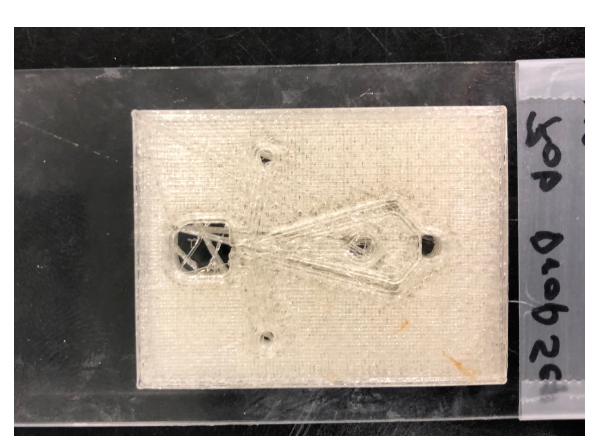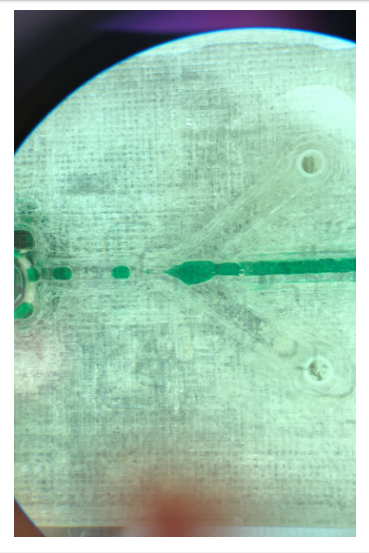In ‘3D Printing a Microfluidic Chip Capable of Droplet Emulsion Using NinjaFlex Filament,’ Robert Andrews from the University of Arkansas 3D prints a novel microfluidic system for his thesis project and paper. Relying on NinjaFlex filament, the process is centered around droplet emulsion—and the BioMEMS (bio microelectromechanical systems) project.
Another main element in this project is the development of a lab on a chip, also delving into miniaturization (technology shrunken into a much smaller environment), with benefits like:
- Reduced necessary sample sizes
- Shortened reaction times of lab processes
- Greater mobility in lab processes
In the lab-on-a-chip scenario, the scale is around 10-1000 µm, but many of the common processes for making such an environment are time consuming and expensive—which is why 3D printing is such an attractive medium for miniaturization. Andrews points out the need for suitable fluid flow, which occurs with a pressure gradient or flexible diaphragm, and must be situated along the microfluidic channel.
“Depending on the material and the thickness of the diaphragm, varying pressures and frequencies would be needed to achieve a certain flow rate,” states Andrews. “As a side note, these diaphragms can also be used either to modify the width of the microchannel, or as check valves if the pressure is increased beyond a certain threshold (enough to cause the displacement of the diaphragm to be equal to the diameter of the microfluidic channel).”
In his thesis project, Andrews works to determine what limitations there may be on the printing process, along with designing the microchip. The microfluidic droplet separators would work within a host of applications, to include blood monitoring (for clots), food safety chemical detection, and discovery of new drugs in pharmaceuticals. The author also points out how beneficial it would be to create a system using NinjaFlex—in comparison to more conventional methods.
“3D printing in NinjaFlex rather than ABS has one inherent advantage for the specific application of generating microfluidic systems. NinjaFlex has a Young’s modulus of 12 MPa, while that of ABS is 2.05 GPa. This results in ABS having a stiffness roughly 170 times that of NinjaFlex,” Andrews wrote.
“This reduction in stiffness is advantageous for fabrication of microfluidic systems because these systems may need actuators that need to flex and bend to generate fluid flow. Much less pressure is needed to generate a deflection in NinjaFlex than to generate that same deflection in a geometrically similar sample of ABS.”
Through ‘trial and error,’ Andrews was able to find the best printing parameters for fabricating the chip. There were also some worries about the chip design, concerning major defects with blockage, and the first print was a bit rough, including:
- Print quality distortion
- Blocking of the outlet
- Chip is too thick
- No visibility of micro channels or diaphragm
“With respect to the 3D printer itself, it was noted that jams often occurred at this extruder temperature,” states the author. “Because of this, temperature was increased to 250 C. Jams occurred much less frequently, if at all, at this extruder temperature.
“With respect to design changes in the next iteration, the top of the chip was removed in the part file, leaving the channels viewable from above. Instead of a top composed of NinjaFlex, the microchip would be capped with a glass chip.”
The Angled Junction Version 3 chip was the first used with droplet emulsification, as water colored with green food dye was filtered through to ensure the channel was not blocked. The microchannel turned green, but Andrews points out that the bond between the filament and the glass was not very good. Water leaked from the chip—and it ended up separated from the substrate.
After continued refining, Andrews was able to bring the flow rate down, with the oil side pressure maintaining the same levels. Afterward, ‘consistently sized droplets’ were created at regular intervals.
“There are various ways that this final design of the microchip could be improved. First, the diameter of the channels could be decreased to reduce the size of the droplets. However, the channels cannot be made so small that they become blocked. Also, diaphragms could be implemented on either side of the outlet channel. By actuating these diaphragms, the microchannel size can be changed and, consequently, the size of the droplets could be accurately controlled. The chip could be made thicker to allow the tube connectors to have more surface to grab onto,” concluded Andrews.
“The overall design of the experiment could also be improved. Generating the oil flow rate would be better accomplished using a syringe pump rather than using the nitrogen tank as a pressure source. Since not much pressure is needed to pump the oil, the nitrogen tank is not accurate enough to produce a reliable and consistent oil flow rate.”
The future has arrived in many different forms of research and industrial innovation, but it may be different from what many of us imagined; for instance, miniaturization is becoming more common, from forays into flow channel miniaturization to continuous flow reactors, and different materials and processes for miniaturization and microfluidics. What do you think of this news? Let us know your thoughts! Join the discussion of this and other 3D printing topics at 3DPrintBoard.com.
[Source / Images: ‘3D Printing a Microfluidic Chip Capable of Droplet Emulsion Using NinjaFlex Filament’]Subscribe to Our Email Newsletter
Stay up-to-date on all the latest news from the 3D printing industry and receive information and offers from third party vendors.
Print Services
Upload your 3D Models and get them printed quickly and efficiently.
You May Also Like
XJet Continues Its Push to Lower Barrier-to-Entry with Carmel Pro 3D Printer
Over the summer, Israeli metal and ceramic additive manufacturing (AM) original equipment manufacturer (OEM) XJet announced the sale of a Carmel 1400M metal 3D printer to Youngstown Business Incubator (YBI),...
3D Printing Financials: Invisalign Demand Keeps Align’s 2025 Growth on Track
Align Technology‘s (Nasdaq: ALGN) third quarter showed a company tightening its operations while keeping growth steady. Demand for its Invisalign clear aligners continued to drive growth, led by rising demand among...
AM Takes on the Heat Challenge: Join EOS, Sintavia & nTop for a Free Webinar on Thermal Management
The webinar “Optimizing Thermal Management with Additive Manufacturing”, hosted by EOS and featuring AM contract manufacturer Sintavia and AM software provider nTop, is only two days away! You can register...
OneClickMetal Turns Up the Heat With 500W LPBF Machine for €120,000
OneClickMetal has been making affordable metal LPBF systems in Germany for several years. Started by Trumpf, the company is now owned by innovative machine tool manufacturer Index. OneClickMetal’s machines are...








































